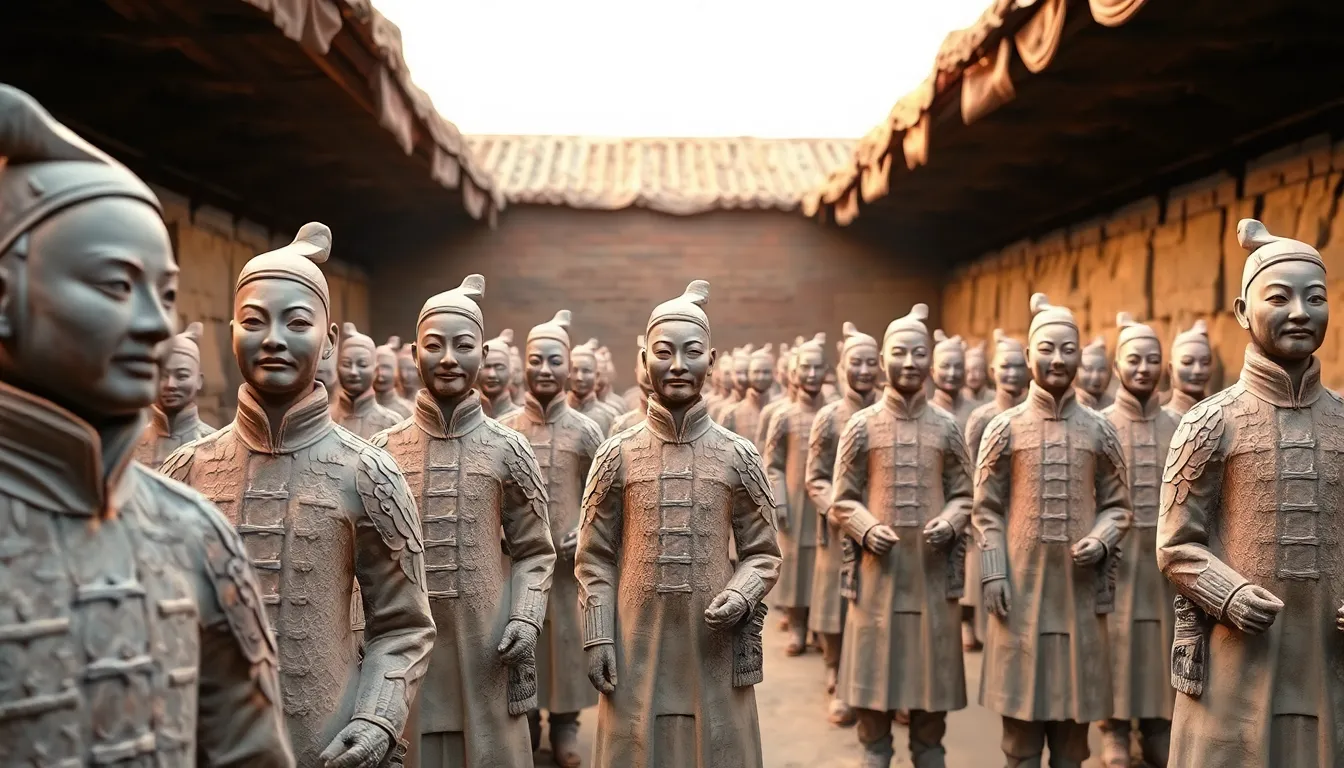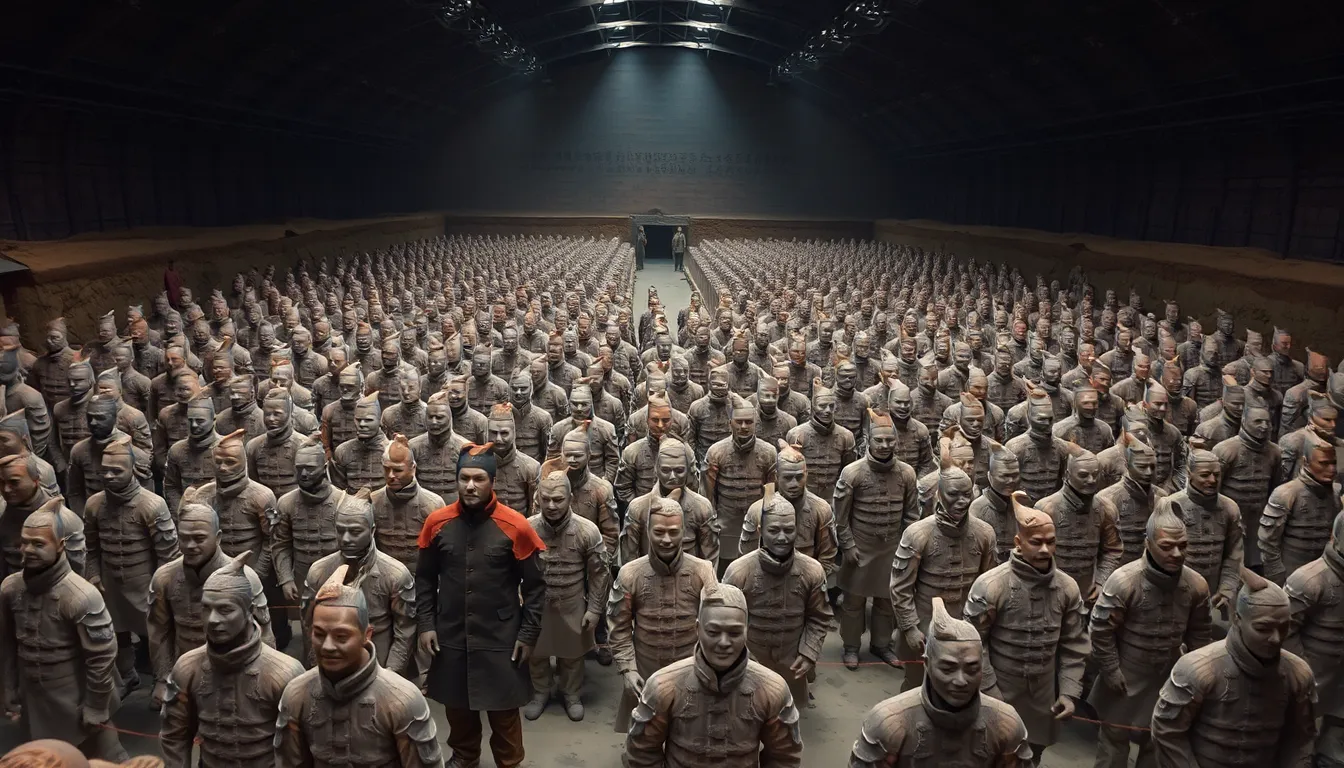Deep beneath the earth in Xi’an, China lies an army unlike any other—thousands of life-sized terracotta soldiers, each with its own unique features. But why did Emperor Qin Shi Huang go to such great lengths to create this underground battalion? Was he just a fan of clay crafts or was he preparing for something a bit more monumental?
Table of Contents
ToggleHistorical Context of the Terracotta Soldiers
The Terracotta Soldiers emerged during a pivotal period in Chinese history marked by unification and imperial ambition. This remarkable creation reflects the Qin Dynasty’s attributes and the profound influence of its first emperor.
Qin Dynasty Overview
The Qin Dynasty lasted from 221 to 206 BCE. It unified various warring states into a singular entity, establishing centralized control. This era emphasized legalism, promoting strict laws and harsh penalties to maintain order. Innovations in infrastructure included standardizing measurements and creating an extensive road network. The dynasty also initiated monumental projects such as the Great Wall of China. These developments facilitated trade and military mobility, solidifying the dynasty’s power.
The Rise of Emperor Qin Shi Huang
Emperor Qin Shi Huang became the first emperor of a unified China in 221 BCE. His rise followed the collapse of the feudal system, driven by ambitious political strategies and military conquests. By employing shrewd alliances, he expanded territory and eliminated rivals. Qin Shi Huang sought immortality, believing that a grand tomb filled with an army of terracotta soldiers would protect him in the afterlife. This vision demonstrated his authority and desire for eternal glory, influencing the soldiers’ creation.
Purpose Behind the Creation

The terracotta soldiers were created for multiple significant purposes, reflecting the ambitions of Emperor Qin Shi Huang and the values of the Qin Dynasty.
Protecting the Emperor in the Afterlife
Creating the terracotta army was a strategic move to safeguard the emperor in the afterlife. Countless soldiers stood vigilant, forming a protective barrier around the emperor’s tomb. This portrayal of an army symbolized Qin Shi Huang’s belief in the afterlife and the need for protection against potential threats. Statues represented not just military might, but also the spiritual need to ensure safe passage and eternal rule. By surrounding himself with these figures, he aimed to maintain authority even in death.
Symbol of Military Power
Besides safeguarding the emperor, the terracotta soldiers served as a powerful symbol of military strength. Each figure displayed distinct features, signifying a diverse and robust military presence. The size and grandeur of the army illustrated the emperor’s desire to showcase his conquests and the might of the Qin Dynasty. This impressive display underscored the centralized power and organization of Qin forces, reinforcing the emperor’s dominance over rival states. These soldiers epitomized the principle of strength through unity, emphasizing the importance of military prowess during the era.
Artistic and Cultural Significance
The terracotta soldiers carry immense artistic and cultural significance. These figures not only represent the emperor’s power but also showcase the exquisite craftsmanship of the time.
Techniques Used in Construction
Techniques employed in creating the terracotta soldiers reflect advanced artistry. Each soldier features hand-crafted details, emphasizing individuality among the thousands of figures. Workers utilized local clay, sculpting it into realistic forms before firing them in kilns. The process involved precise molding techniques combined with intricate painting to enhance features and attire. Such innovation demonstrated an understanding of artistry and engineering that characterized the Qin Dynasty.
Influence on Chinese Art and Culture
Influence on Chinese art and culture remains profound. The terracotta soldiers inspired generations of artisans, leading to innovations in sculpture and pottery. Their distinct poses and expressions paved the way for future representations of military figures in art. Many cultural aspects, including conceptions of immortality and the afterlife, drew inspiration from these creations. The soldiers also serve as a symbol of national pride, showcasing China’s rich historical legacy to the world.
Recent Discoveries and Research
Recent archaeological efforts have unearthed new insights about the terracotta soldiers. Excavations continue to reveal additional pits containing these remarkable figures, emphasizing the vast scale of this underground army.
Archaeological Findings
Excavations in Xi’an now include over 8,000 soldiers, along with chariots and horses. Discoveries indicate variety in ranks and roles within the army, enhancing understanding of the Qin military organization. Noteworthy findings include the identification of weaponry, such as crossbows and spears, alongside the soldiers. Each reveal underscores the advanced techniques and strategic planning of that era.
Insights from Modern Science
Recent scientific analyses employ imaging technologies, offering unprecedented views of the soldiers’ construction methods. Techniques like CT scanning provide insights into the materials and processes used. Moreover, chemical composition studies of the pigments reveal details about the vivid colors originally present. Such efforts illustrate the complexity of the artistry surrounding each soldier and contribute to knowledge about ancient Chinese craftsmanship.
The terracotta soldiers stand as a testament to Emperor Qin Shi Huang’s ambition and the rich history of the Qin Dynasty. Created to protect the emperor in the afterlife they symbolize both military strength and artistic innovation. Each figure reflects the unique craftsmanship of the era showcasing the diversity and organization of the Qin military.
Recent archaeological discoveries continue to shed light on the complexity of this underground army revealing insights into ancient Chinese culture and artistry. The terracotta soldiers not only highlight the emperor’s quest for immortality but also serve as a powerful reminder of China’s enduring legacy and the profound influence of its historical figures. Their significance transcends time inspiring admiration and curiosity in generations to come.








